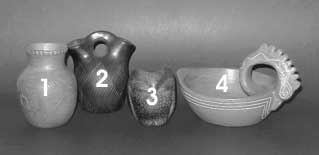Native clays are dried, ground carefully between two hard stones,
small pieces of stone and other impurities are sifted out, and then
the fine-ground clays are soaked until they absorb as much water as
possible.
The clay is then "worked" by squeezing with the hands, paddling
with a wooden paddle, and generally kneaded until the right
thickness or "gooiness". The clay is kept moist until ready to use.
Occasionally a little sand or ground seashells are added to the clay
to "temper" or make it stick together better.
When ready to use, the potter will squeeze the clay into "ropes"
around to the size and shape of the pot she desires. Each successive
layer is squeezed tight to the layer below, trying to get all the
air out that might be trapped between the layers. After the bowl is
shaped, it will be smoothed with a flat stick or polishing stone
until the surfaces are hard and shiny. Sometimes designs are made in
the clay with a sharp stick; other times, a carved paddle is used to
"paddle" the design into the still moist clay.
The pot would be set aside in the sun for several days to dry
thoroughly, then "fired" in a fireplace. Several methods were used
to fire the pottery, but the one most used by the Cherokees of the
period was to fill the pot with burning ground corncobs or bark
burning inside would make the pot more waterproof.
From the pamphlet, "The Village at Tsa-la-gi"@
http://www.angelfire.com/ks2/tsalagilanguage/pottery.html
See also:
Eastern Band in North Carolina -
http://www.cherokee-nc.com/
Western Band in Arkansas and Missouri -
http://www.westerncherokee.net/
Western Band in Oklahoma -
http://www.cherokee.org/
 ClayHound Web
- Cherokee Pottery
ClayHound Web
- Cherokee Pottery
